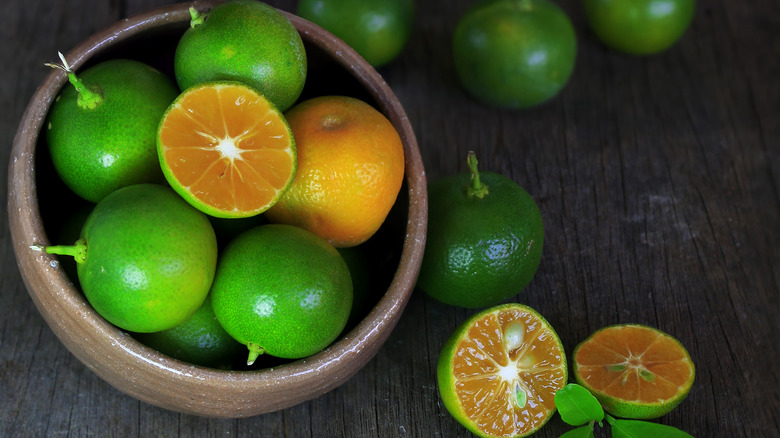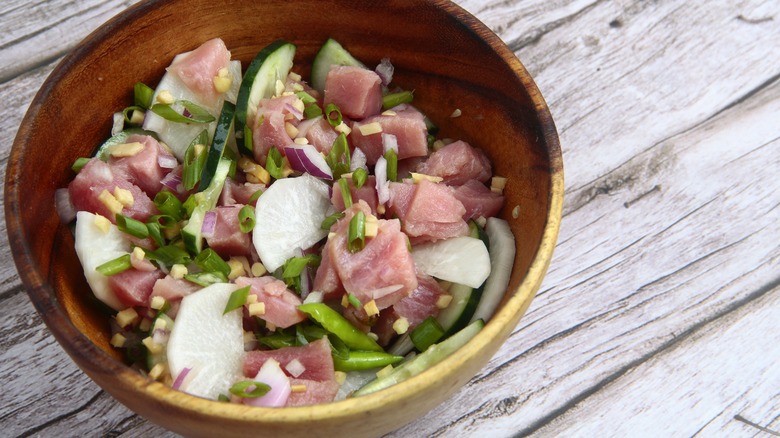Calamansi Limes: The Fruit You Need To Pair With Every Filipino Meal
The Philippines is a beautiful collection of exotic islands with a culture as warm and hearty as its food. When talking about Filipino food, you may already be familiar with Jollibee — one of the fastest-growing restaurant brands of 2023. But fast food aside, there is more to Filipino cuisine than this chain's famous fried chicken. Colonized by the Spanish, the Filipino language is not the only place you'll find influences from this period. Aspects of the cuisine echo Spanish culture (particularly lechon), while other elements speak to the Asian roots (with many rice dishes originating from India).
One small, green detail ties together this rich history and finds its way into almost every Filipino dish. The calamansi lime, or "kalamansi" in Tagalog, is thought to have long been cultivated on the Hainan Island of China, yet is now of equal economic and culinary importance across the Philippines. Its quintessential flavor embodies one of the most dominant tastes in Filipino cooking: sour. The calamansi lime has plenty of secrets under its skin, and you'll soon realize its flavor is crucial to any Filipino meal you plan to prepare. Unless, of course, you're planning to serve hot dogs and marshmallows (a serious Filipino party food).
A fruity kind of lime
These limes may look ordinary, especially when bought unripe and their skin is bright, shiny green. But don't be fooled by the exterior. Once these little green orbs ripen, their skin takes on a hue that eventually resembles a bright orange. Since it can take up to a year for the calamansi to ripen, these fruits are often used before they mature. Once you slice into these vibrant spheres, you may be surprised by the brilliant orange flesh and cream-colored seeds that are revealed. This is no surprise when you learn that calamansi is a hybrid citrus fruit from kumquats and mandarins.
Between its segments, the calamansi has a wonderfully fruity sourness. Imagine the tart taste of an orange, lemon, and lime combined. Well, that's precisely the bold, juicy flavor these green balls provide.
In its simplest form, the calamansi is used as a seasoning, similar to salt and pepper. Just cut off the end and squeeze over Filipino noodles (pancit), curries (kare-kare), or seafood. You can even make a simple Filipino lemonade with calamansi juice, water, and simple syrup. Perfect for a summer afternoon! If you want to try this flavor before investing, you can find calamansi iced milk tea at The Teapsy in New York City.
How to turn that calamansi frown upside down
If this fruit has inspired you to try some Filipino recipes, why not try making toyomansi, a Filipino dipping sauce and marinade? Toyomansi combines calamansi with soy sauce and fresh bird's eye chilis to create a light, punchy dip. As a marinade, toyomansi can also be used to create the most famous Filipino dish, adobo. Usually made with pork, chicken, or beef, adobo is hearty, tangy, and deeply savory. The calamansi brings a wonderful citrusy kick to the meat that echoes the lively flavors of the Philippines.
Kinilaw is another Filipino dish that uses calamansi limes in a marinade style. Zingy and refreshing, kinilaw is marinated fish or seafood almost akin to ceviche — delightful as a light lunch. It's also great to know that calamansi limes are not only a flavorful fruit but also a great source of beneficial nutrients such as vitamin C, potassium, and calcium. Due to their nutritional content, they are believed to help with high blood pressure, asthma, and overall immune system strengthening. The next time you prepare a Filipino feast, make sure you get your hands on some calamansi for an added vitamin boost and seriously bring those tropical vibes.


